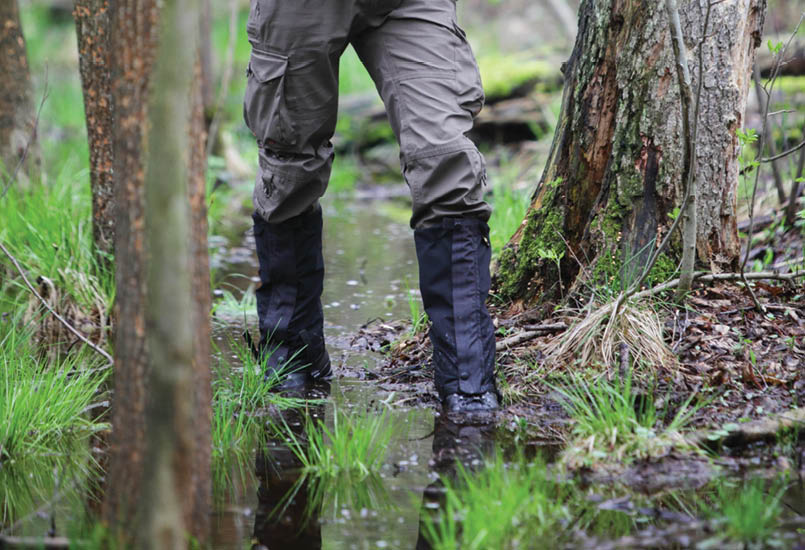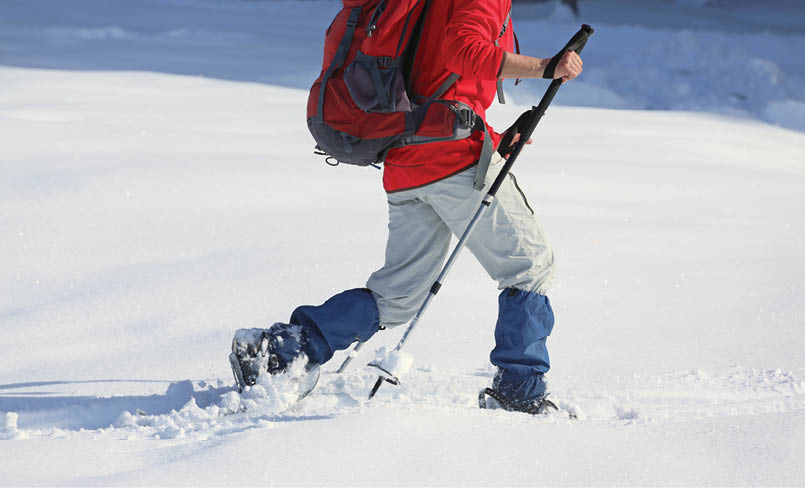



The decision on whether or not to wear gaiters really depends on where you are walking. It's a question that seems to be asked a lot online, with new bushwalkers seeing others with these carefully crafted things wrapped around their legs and wondering what they're for. Here are a few of the advantages of wearing gaiters.
Scott on the summit of Minotaur with Mount Gould in background
Gaiters
Scott King

56 | BWA February 2017
Why wear them?They stop your boots filling up with mud, sand, leaves, or snow. If you spend a day walking without gaiters you'll quickly find you are dealing with stuff starting to fill up your socks and boots. Leeches and ticks also fall into this category of things you don't want on your legs and in your socks! Note that gaiters will not stop all detritus, just most. Also, leeches and ticks can burrow past clothing. However, gaiters are a very good barrier.
They protect your lower legs. Most people find that the Australian bush is quite abrasive and will start to wear through the bottom of your favourite walking pants, or if you like to wear shorts then the scratches on your legs will have you wishing you had some protection. This is particularly relevant for off-track walking.
They keep your feet dry. Mud, puddles and wet undergrowth all seem to be out to get water inside your nice dry boots. Gaiters can keep your feet dry for a few days if you're careful. Wet feet can lead to blisters, so best to keep your feet dry.
Snakes! Many ask if gaiters are snake-proof. Of course this is difficult to test! Bushwalking gaiters are not snake-proof but they definitely can help if a snake thinks you are worth biting. Heavier gaiters made of canvas, Cordura or the like are better at resisting snake bites. One person has sewn ballistic fabric into his gaiters, the material used in so-called bullet-proof vests.
There seems to be no test about gaiters and snakes. A few general comments. Longer heavier gaiters are the most popular, and provide most protection against snakes. However, it may be that heavier gaiters allow a snake to latch onto the gaiter. It may be that with gaiters that seem to be more snake-proof the wearer will take more chances. In snake country – perhaps on most bushwalks – always exercise care about snakes and other hazards.

“Gaiters can keep your feet dry for a few days if you're careful.
BWA February 2017 | 57
Garmin Oregon 650 near Mt RufusWeiyun Yu
What types of gaiters are there?Ankle high These are great for trail running and travelling in dry, hot environments where sand and seeds are likely to fill up your shoes.
Alpine and Cross Country Skiing Designed to keep out snow and ice, these are usually reserved for mountain adventures above the snow line.
General purpose This is the type seen most at popular places like Tasmania's Overland Track. These gaiters take many forms and are the topic of much discussion and debate at campsites and online.
FabricThe fabric used in gaiters is critical to how useful and durable they'll be. So what materials are best?
Nylons These are some of the most abrasion-resistant fabrics available, so are great for gaiters. Sometimes called Cordura or Kodra. They are usually polyurethane coated on the inside. Some of the cheaper gaiters are made entirely from these fabrics; the more expensive types tend to use them on just the lower sections, where abrasion is a problem.
BreathableGore-tex, eVent or other varieties of these fabrics are used on the more high-end gaiters. They are not the best fabrics for abrasion so will commonly be used for the upper sections. There is a lot of debate regarding which of these fabrics is the most breathable. These fabrics use Durable Water Repellent (DWR) which is an invisible coating on the outer layer, making water bead on the surface to ensure the fabric can still breathe when wet. When used on gaiters the DWR tends to wear off really quickly meaning once wet, they don't breathe at all. With a bit of sweat, over time the pores in the breathable membrane tend to clog up meaning even when dry, breathability is not that great. There is also the annoying problem of them falling down if they are not tight around your leg.
Canvas My personal favourite for gaiter uppers. It's breathable when dry and waterproof when wet. Canvas is also very durable and will live through years of abuse and still be in one piece. It's also quite stiff which means gaiters tend to be able to hold themselves up without being tight around the leg.

“When used on gaiters the DWR tends to wear off really quickly meaning once wet, they don't breathe at all.
58 | BWA February 2017
Scott and his family live in Tasmania's north in the Tamar Valley. His father introduced him to bushwalking, dragging him on extended trips as a reluctant teenager. He never quite understood his father's passion for the Tasmanian bush until he was older but now takes every opportunity to get out and explore in remote areas. In his spare time you will find him climbing some of the lesser-known Tasmanian mountains on the Abels list ... He started Tasgear after seeing a need for gear that would be suited to the conditions encountered in Tasmania. He believes that an island with such a strong bushwalking community should have locally made gear.


The perfect pair of gaiters can be pleasant to wear, you forget you have them on and you can enjoy your walk. Poor quality gaiters can be annoying and have you worrying about them instead of enjoying your walk. Worse still, you end up just taking them off and carrying them!
Top tips for general purpose gaiters
Choose gaiters that will hold themselves up. The best way to avoid sweaty legs is to be able to open the top of the gaiters and let some air flow in. If your gaiters don't have this stiffness then you'll need to have them tight around your calves, trapping all that heat in. The best breathability you'll get is to be able to open the top of the gaiter when it's hot.
Make sure your gaiter is low enough to overlap your footwear. If you wear trail runners then you need to make sure you get a good amount of cover by a gaiter that sits nice and low. Many designs are made with boots in mind and aren't really suitable for low-cut shoes.
Weight on your feet can be really taxing on a long walk so choose gaiters that are suitable for the type of walking you are doing. If you tend to walk mainly on formed tracks and won't be seeing too much scrub then choose light gaiters. If you plan on heading off track then invest in a good pair of heavy, high-fitting gaiters that will give you maximum protection. The extra weight of these easily pays off when the going gets tough.
If you wear long pants, tuck them into the gaiters so that the pants hang over the top of the gaiters. This means that small pieces of scrub, pebbles and dirt will flow over the fold and outside.
Gaiters generally fasten at back or front. The front is easier to access and the back has more protection from scrub. Studs are good providing they can be done up, which may not be the case unless the gaiters are a size bigger than the boots and legs. Velcro may work well if it's wide enough. The gaiter hook for the lower boot lace needs to have depth so that it will not jump out.
The most important thing is that you get out there and find out what you like, nothing like a few days in the wilderness to give you time to think about all the pros and cons of your gaiters. See you out there!

“Many designs are made with boots in mind and aren't really suitable for low-cut shoes.
BWA February 2017 | 59